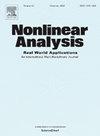Global attractors for Moore–Gibson–Thompson thermoelastic extensible beams and Berger plates
IF 1.8
3区 数学
Q1 MATHEMATICS, APPLIED
引用次数: 0
Abstract
For , and , we consider an abstract version of the system describing the dynamics of thermoelastic extensible beams or Berger plates, where the evolution of the temperature is ruled by a regularized Moore–Gibson–Thompson type equation. The existence of a global attractor of optimal regularity is proved.
Moore-Gibson-Thompson热弹性可展梁和Berger板的全局吸引子
对于 p∈R,且 α,β,γ,δ,η>;0 时,我们考虑一个抽象版本的系统 utt+Δ2u-(p+‖∇u‖2)Δu=ηΔ(ϕtt+αϕt)+fϕttt+αϕtt-βΔϕt-γΔϕ-δΔϕtt=-ηΔutdescribing 热弹性可伸展梁或贝格板的动力学、其中,温度的演化由正则化的摩尔-吉布森-汤普森(Moore-Gibson-Thompson)型方程决定。证明了最优正则性全局吸引子的存在。
本文章由计算机程序翻译,如有差异,请以英文原文为准。
求助全文
约1分钟内获得全文
求助全文
来源期刊
CiteScore
3.80
自引率
5.00%
发文量
176
审稿时长
59 days
期刊介绍:
Nonlinear Analysis: Real World Applications welcomes all research articles of the highest quality with special emphasis on applying techniques of nonlinear analysis to model and to treat nonlinear phenomena with which nature confronts us. Coverage of applications includes any branch of science and technology such as solid and fluid mechanics, material science, mathematical biology and chemistry, control theory, and inverse problems.
The aim of Nonlinear Analysis: Real World Applications is to publish articles which are predominantly devoted to employing methods and techniques from analysis, including partial differential equations, functional analysis, dynamical systems and evolution equations, calculus of variations, and bifurcations theory.

 求助内容:
求助内容: 应助结果提醒方式:
应助结果提醒方式:


